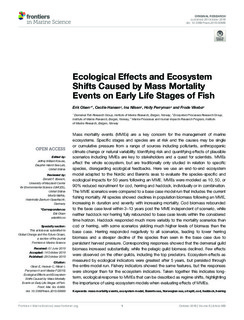| dc.description.abstract | Mass mortality events (MMEs) are a key concern for the management of marine ecosystems. Specific stages and species are at risk and the causes may be single or cumulative pressure from a range of sources including pollutants, anthropogenic climate change or natural variability. Identifying risk and quantifying effects of plausible scenarios including MMEs are key to stakeholders and a quest for scientists. MMEs affect the whole ecosystem, but are traditionally only studied in relation to specific species, disregarding ecological feedbacks. Here we use an end-to-end ecosystem model adapted to the Nordic and Barents seas to evaluate the species-specific and ecological impacts for 50 years following an MME. MMEs were modeled as 10, 50, or 90% reduced recruitment for cod, herring and haddock, individually or in combination. The MME scenarios were compared to a base case model run that includes the current fishing mortality. All species showed declines in population biomass following an MME, increasing in duration and severity with increasing mortality. Cod biomass rebounded to the base case level within 3–13 years post the MME independent of scenario, while neither haddock nor herring fully rebounded to base case levels within the considered time horizon. Haddock responded much more variably to the mortality scenarios than cod or herring, with some scenarios yielding much higher levels of biomass than the base case. Herring responded negatively to all scenarios, leading to lower herring biomass and a steeper decline of the species than seen in the base case due to persistent harvest pressure. Corresponding responses showed that the demersal guild biomass increased substantially, while the pelagic guild biomass declined. Few effects were observed on the other guilds, including the top predators. Ecosystem effects as measured by ecological indicators were greatest after 5 years, but persisted through the entire model run. Fishery indicators showed the same features, but the responses were stronger than for the ecosystem indicators. Taken together this indicates long-term, ecological response to MMEs that can be described as regime shifts, highlighting the importance of using ecosystem models when evaluating effects of MMEs. | nb_NO |
